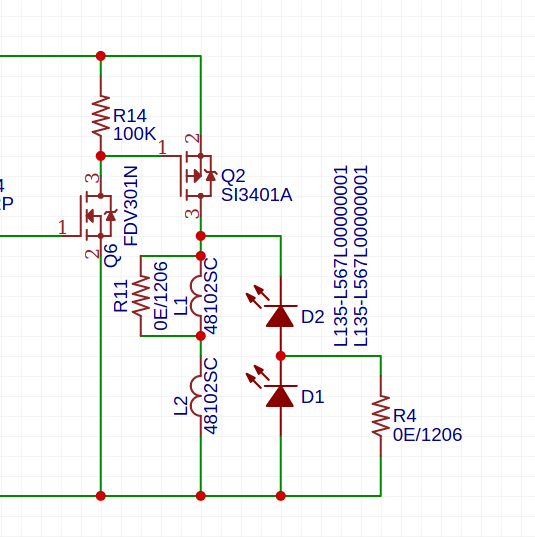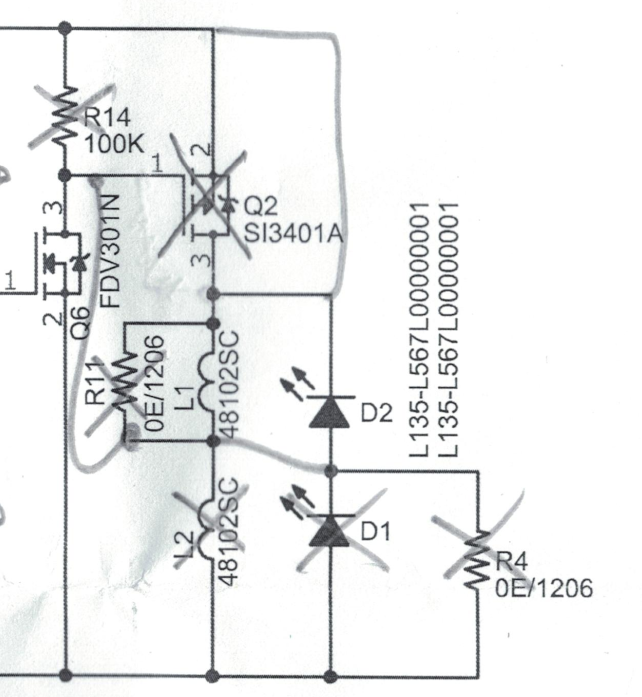Lessons learned from #TritiLED
- 530nm peak falls in between the scotopic (507nm) and photopic (555nm) human eye sensitivity peaks.
- Efficient way of driving the LED by connecting it as protection diode in a relay. It's better than connecting it as in a boost LED driver because that leaves a current path to ground at all times.
Series resistor
The simplest, but certainly not the most efficient way to drive an LED. To limit power consumption, the resistor should be chosen as large as possible. Unluckily LEDs are not very efficient at these low currents.
Fly back diode on inductor
The current through the LED will be a sawtooth with a falling slope (unlike a rising slope in the image below). That doesn't impact the RMS-value.

In our case, delta will be 100%, or 1. So the peak current in the saw tooth is 1.73 times the RMS-current in the sawtooth pulse. For an RMS-current of 5mA, we must generate a sawtooth with a peak current close to 9mA.
As our supply voltage will be fixed, the only parameters left to play with, are the inductance value and the pulse width.
Parameters
- Pulse frequency : greater than or equal to 50Hz to avoid flickering
Simplified calculations
Simplified in a way that no losses are taken into account.
Needed pulse width
You could choose a smaller inductor value, but this also decreases the pulse width. Smaller pulse widths require smaller RC-combinations for the one-shot timer. This will lead to increased loss (smaller R) or less precision (C is only a few picofarads).
Either one or two LEDs will be used as a load. When two LEDs are connected in series, the inductor current drops to zero in about half the time as when only one LED would be connected. Either the LEDs are still bright enough, then the 1mH inductor can remain. If not, then the inductor value and pulse width can be doubled.
Current consumption
Here we calculate the DC-current consumption, as would be shown on a multimeter feeding this circuit.
Schematic

The LED driver itself is quite simple. If Q2 conducts, current starts rising in the inductors. Once Q2 stops conducting, the inductor will create a negative voltage on the cathode of D2, and the current will flow through the LEDs.
The extra inverter consisting of Q6 and R14 has been added because I didn't want to add an extra transistor to the BoM, instead I reused the FDV301 and the SI3401A.
This circuit doesn't work as intended, i.e. creating 3µs ON-times for Q2. Can you spot the error?
I overlooked the discharging of the Q2 gate capacitance. To pull Q2 into conduction, Q6 conducts and charges Q2 fast. When Q6 stops conducting however, the Q2's gate has to discharge through R14, which is 100K. This takes about 180µs!
The dirty remedy would be to drastically lower R14, but that will also lead to a waste in current. The nice solution is to replace Q6 by a low Rdson NMOS and connect the LEDs and the inductors between the VCC and the drain of Q6.
For Q6, #TritiLED uses the IRLML6244TRPBF, but that MOSFET has a total gate charge of 8.9nC.
I think there's no point in selecting the NFET with the lowest possible Rdson, because the bulk of the resistive loss occurs in the inductors, which have 1.85ohm series resistance each.

The current consumption of this setup is about 1.45µA, which is much higher than what was expected. What is going on?
- When replacing the inductor || LED with a 1Mohm resistor, the current consumption is still 280nA.
- Replacing Q6 with a 1Mohm resistor to GND : 77nA.
- When disconnecting the Q output of the monostable, current consumption drops to 66nA.
It's clear that the (gate) losses of the MOSFET have to be taken into account, as pointed out on MOSFET power losses and how they affect power-supply efficiency. The BSS806NH6327XTSA1 might be a better choice as switching element because of its much lower gate charge. When the monostable drives the BSS806 with a 1Mohm resistor, the current consumption is 220nA. So we win 60nA in comparison to the ZXMN2F30FHTA.
 Christoph Tack
Christoph Tack
Discussions
Become a Hackaday.io Member
Create an account to leave a comment. Already have an account? Log In.